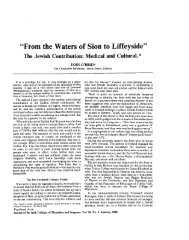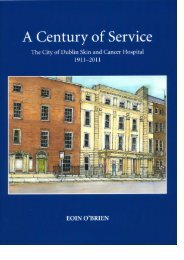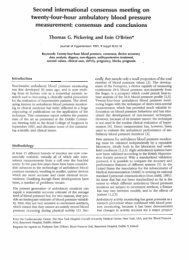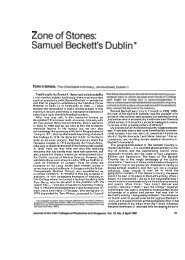Nevill Johnson: Paint the smell of grass - Eoin O'Brien
Nevill Johnson: Paint the smell of grass - Eoin O'Brien
Nevill Johnson: Paint the smell of grass - Eoin O'Brien
You also want an ePaper? Increase the reach of your titles
YUMPU automatically turns print PDFs into web optimized ePapers that Google loves.
124 <strong>Nevill</strong> <strong>Johnson</strong> l <strong>Paint</strong> <strong>the</strong> Smell <strong>of</strong> Grass<br />
who may tell <strong>the</strong> tale<br />
<strong>of</strong> <strong>the</strong> old man?<br />
weigh absence in a scale?<br />
mete want with a span?<br />
<strong>the</strong> sum assess<br />
<strong>of</strong> <strong>the</strong> world’s woes?<br />
nothingness<br />
in words enclose? 1<br />
<strong>Johnson</strong>’s perception <strong>of</strong> Dublin in <strong>the</strong> fifties is important. He saw <strong>the</strong> city as one from without<br />
and unlike indigent commentators, such as Cronin and Ryan, he had no need to eulogise <strong>the</strong><br />
‘characters’ <strong>of</strong> <strong>the</strong> city who, unlike those, such as Joyce and Beckett, with <strong>the</strong> guts to give <strong>the</strong><br />
place <strong>the</strong> treatment it deserved by gazing back from afar, were being assiduously packaged and<br />
labeled for export to an outer world, which believed that leprechauns in green tweed strode <strong>the</strong><br />
sidewalks <strong>of</strong> Grafton and O’Connell Street – and who would disillusion <strong>the</strong>m? <strong>Johnson</strong>’s view <strong>of</strong><br />
Dublin did not deny <strong>the</strong> eccentricities <strong>of</strong> its people, <strong>the</strong> peculiarities <strong>of</strong> <strong>the</strong>ir behaviour, <strong>the</strong><br />
hypocrisy <strong>of</strong> <strong>the</strong>ir beliefs, ra<strong>the</strong>r he saw <strong>the</strong> city for what it was and loved it all <strong>the</strong> more deeply:<br />
“Through its people, thronged as <strong>the</strong>y were by dogma and tacitly in thrall to <strong>the</strong> hereafter, ran a<br />
maverick undertow; <strong>the</strong>se folk laughed and winked like boys behind Godmaster’s back. Wit and<br />
a casual intelligence was <strong>the</strong> key to this society; today was fine – nd tomorrow would be very<br />
welcome.” <strong>Johnson</strong> regarded Dublin <strong>of</strong> <strong>the</strong> fifties as a stimulating place and he may well have<br />
been right. It certainly bred an interesting array <strong>of</strong> talent provided <strong>the</strong> talent survived. “The price<br />
was sometimes high; some drifted in a whirlpool <strong>of</strong> lost endeavour, some drowned…The bar stool<br />
supported some, o<strong>the</strong>rs it captured, and for some <strong>the</strong> snugs were tombs.”<br />
The artist in <strong>Johnson</strong> sensed in Dublin what Dubliners <strong>the</strong>mselves could not sense and what<br />
<strong>the</strong> planners <strong>of</strong> <strong>the</strong> next decade were oblivious to, namely that this capital microcosm had been<br />
suspended in time, its people as though from ano<strong>the</strong>r age had been untainted by <strong>the</strong> evils <strong>of</strong><br />
affluence that was contaminating <strong>the</strong> denizens <strong>of</strong> o<strong>the</strong>r capitals <strong>of</strong> <strong>the</strong> world; an aura <strong>of</strong> innocence<br />
and purity pervaded <strong>the</strong> place. “Buttressed by piety, capped and shod by wit and crafty indolence,<br />
even <strong>the</strong> poorest lived out a strange Dickensian scenario. Behind elegant Georgian facades lay an<br />
intimate world <strong>of</strong> brick and iron, timber, and fine though crumbling plaster. The city had not yet<br />
undergone <strong>the</strong> humiliating submission to planners, and that frenetic consumerism which had<br />
begun to afflict <strong>the</strong> capitals <strong>of</strong> Europe. Day to day living passed unhurried, inexpensive, and a<br />
light-footed sanity prevailed.”<br />
1. Beckett S. Watt. Calder and Boyars. London. 1972. p. 274<br />
<strong>Nevill</strong> <strong>Johnson</strong>’s studio<br />
The painter in <strong>Johnson</strong> set out to capture <strong>the</strong> uniqueness <strong>of</strong> Dublin but he substituted <strong>the</strong><br />
lens <strong>of</strong> a camera for brush and canvas, and <strong>the</strong> result was a striking artistic success. Assisted by <strong>the</strong><br />
artist Anne Yeats, <strong>Johnson</strong> walked Dublin <strong>of</strong> <strong>the</strong> fifties “circling like a hunting dog, nose and ear<br />
taking as much as my eye: <strong>the</strong> <strong>smell</strong> <strong>of</strong> hay and feeding stuff in a store <strong>of</strong>f Smithfield, <strong>the</strong> yard<br />
paved with <strong>grass</strong>y flags and setts <strong>of</strong> old blue limestone. And <strong>the</strong>re used to be a knackers’ yard in<br />
Newmarket, whence came on west wind an evil stench <strong>of</strong> bones and hide.” In his introduction to<br />
<strong>the</strong> book he puts his case as a photographer: “As Koestler says, quoting Paracelsus, ‘God can<br />
make an ass with three tails but not a triangle with four sides.’ So, in my photo-hat I cannot build<br />
or rub out – only select, and accept. I cannot in words translate <strong>the</strong> signals; I can only hope to<br />
match <strong>the</strong> image.” <strong>Johnson</strong>’s images <strong>of</strong> a Dublin lost are probably more valuable than any <strong>of</strong> <strong>the</strong><br />
many notable photographic archives, such as Lawrence or Valentine, simply because in <strong>Johnson</strong>’s<br />
case <strong>the</strong> photographer’s eye is that <strong>of</strong> a painter; <strong>Johnson</strong>’s images have a wonderful pathos<br />
because though intent on capturing a sense <strong>of</strong> place he did so by endowing place with its<br />
personalities, <strong>the</strong> residents, <strong>the</strong> joxers on <strong>the</strong> dole, <strong>the</strong> dockers, <strong>the</strong> clergy, <strong>the</strong> poor and down and<br />
outs, hosses and bicycles, pubs and booze. <strong>Johnson</strong>’s photographs <strong>of</strong> Dublin were not published<br />
A Personal Memoir l <strong>Eoin</strong> O’Brien 125









